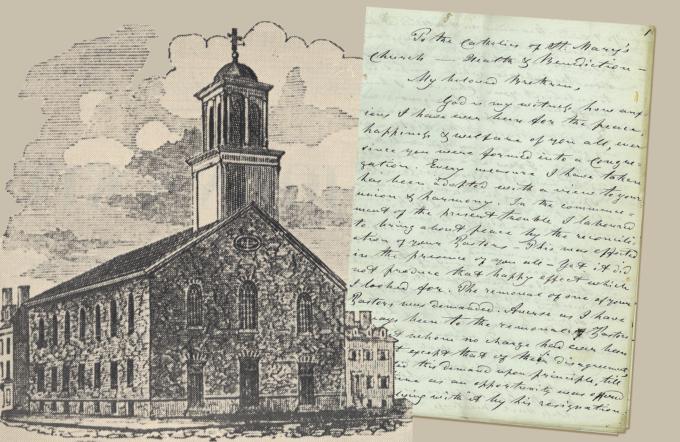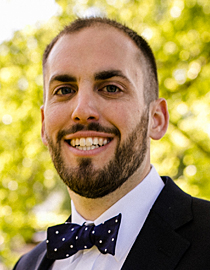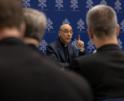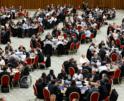
Culture
A riot ensued, which resulted in 18 parishioners being arrested, and five fined for their involvement.

Lester
Within Bishop Fenwick's papers is a letter addressed to the parishioners of St. Mary's Church in Boston's North End, dating to the year 1842. The letter addresses his frustrations with events that had taken place there over the previous months, and would lead to major changes in diocesan policy later that year.
From its dedication on May 22, 1836, there were forces conspiring to threaten the welfare of St. Mary's parishioners. A largely Irish parish, parishioners were often the victims of ridicule and threats, so much so that they appointed several from among themselves to guard the church each night. By 1841, however, the largest threat to the parish came from within.
In 1841, the parish was served by two co-pastors, Father Patrick O'Beirne and Father Thomas O'Flaherty. They shared differences of opinion over reforms needed in the Church, temperance, and other popular issues of the day. These disagreements were found out by parishioners who themselves split across the same lines, taking sides with one pastor or the other. Each side petitioned Bishop Fenwick, advocating for their favorite's appointment as pastor and the removal of the other, but he rejected their pleas.
It is believed that Bishop Fenwick was suspicious of Father O'Flaherty, who he thought had personal ambitions and relished the public support he received, but did not allow for these to obstruct his judgement and take sides. That being said, some of these fears may have been realized when Father O'Flaherty and his supporters began to ally themselves with those from other parishes who favored Trusteeism, a movement to have parishes run by lay-trustees rather than the bishop; a situation which would grant them the power to appoint their own pastor.
By late 1841, tensions had escalated significantly in the parish, and in an effort to calm the situation, Bishop Fenwick spoke at Mass there on Jan. 9, 1842, pleading for harmony and loyalty to their administration's role in managing the diocese. Despite his efforts, those in favor of Trusteeism called for a public meeting later that week. Unsatisfied with his initial effort, Bishop Fenwick called for the parishioners to meet in the church basement the following Sunday to air their grievances and reach an agreement, but the meeting was interrupted by 40 to 50 "disturbers."
Failing to convince the parishioners to make peace, Bishop Fenwick turned to the co-pastors, who publicly reconciled with one another on Jan. 23, 1842. Following what seemed to be a resolution, Father O'Beirne requested a transfer, which was granted. Bishop Fenwick replaced him with Father John Bernard Fitzpatrick, later his successor as Bishop of Boston.
Those who had supported Father O'Beirne were not content, believing that he had been forced out of the parish, and shouted down Father O'Flaherty as he tried to speak at Mass that February. A riot ensued, which resulted in 18 parishioners being arrested, and five fined for their involvement.
With few options remaining, Bishop Fenwick transferred Father O'Flaherty out of the parish as well, hoping that this would finally bring the matter to a close. Father Fitzpatrick stayed at the parish and was assisted by Father Patrick Flood, who succeeded the former when he was transferred to appease another quarreling parish in Cambridge.
Unfortunately for Bishop Fenwick, some parishioners were not satisfied with the outcome of events, and sent Bishop Fenwick a petition signed by 3,300 Boston Catholics in support of Father O'Flaherty returning to the parish. When they received no reply, they took to the newspapers to criticize the bishop and his policies.
The events as St. Mary's inspired events at parishes outside of Boston, but none escalated to the same proportions. What is most significant is that, as a whole, these events led Bishop Fenwick to call for the first diocesan synod. This meeting of all diocesan priests was called to discuss rules and regulations, and establish administrative procedures across the diocese. Bishop Fenwick felt that the Trusteeism movement was largely caused by ambiguity over the roles of the clergy and laity in the governance of the Church, and he wanted to provide clarity. As a result of the synod, which warrants a fuller discussion at a later date, it was resolved that the Bishop of Boston owned all Church property, and that he alone could assign diocesan priests to a parish.
Shortly afterward, Bishop Fenwick would invite the Society of Jesus to oversee St. Mary's, after which they appointed their own members to serve the parish.
- Thomas Lester is the archivist of the Archdiocese of Boston.
Recent articles in the Culture & Events section
-
'Dignitas' and the mediaRussell Shaw
-
Scripture Reflection for April 14, 2024, Third Sunday of EasterDeacon Greg Kandra
-
St. Helena's House is established in the South EndThomas Lester
-
Is this synodality?Russell Shaw
-
Poking the hornet's nest of IVFFather Tadeusz Pacholczyk


















